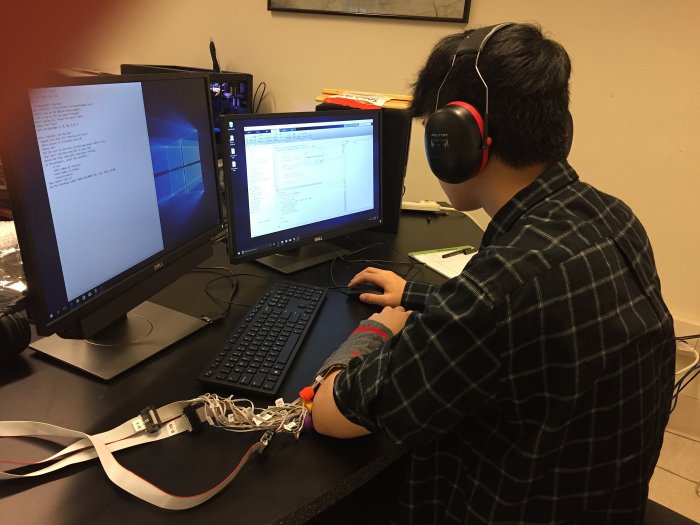Is It Possible To Transmit Messages And Speech Through The Skin? – Researchers Have A Method
MessageToEagle.com – Is it possible to transmit messages and speech through the skin?
Now a method of sending messages in English by using vibrations on a person’s skin has been developed by Purdue University’s research team led by Hong Z. Tan, Purdue professor of electrical and computer engineering.

Tan said she developed the haptic technology [ communication recreates the sense of touch by applying forces, vibrations, or motions to the user] after being challenged by Facebook.
“They wanted to know if it was possible to transmit messages and speech through the skin. We thought it might be possible, and we could give it a try,” she said, in a press release.
Tan and her research group invented the device, which plays a specific vibration that is assigned to a given English phoneme, or the smallest unit of sound, on the user’s forearm.
The sensations coordinate to the phonemes’ formation in the mouth. Sounds at the front of the mouth, such as a “p” or “b,” produce vibrations on the wrist while sounds at the back, such as “g” or “k,” produce vibrations near the elbow. Tan also encoded the device to generate distinct sensations for each speech trait: consonants or vowels, voiced or unvoiced sounds, and long or short vowels.
Stationary vibrations represent consonant sounds while moving sensations represent vowels. Voiced consonants, such as “b,” generate heavier vibrations than unvoiced consonants, such as “p.” Short vowel sounds produce a shorter moving sensation than their long vowel counterparts.
“In testing, we found that people never confused a consonant with a vowel because the sensations are distinct,” Tan said. “We start with a small group of phonemes, then we gradually train people up to 500 words. Everybody’s performance varies, but those who did really well acquired one English word per minute.”
The easy-to-learn technology could have numerous applications as an alternative communication method. Users need only a few hours to learn the vibrations’ associated to different sounds, words or meanings.
According to Tan, the technology could eventually transmit other languages or even environmental stimulus from individual coded maps.
“From the beginning, I really wanted this technology to be a general communication project and to prove that information can be transmitted through touch,” Tan said. “People with sensory deficits need to be able to hear a car honking or the faucet running, so we can create a sensation specifically for that. Or, for example, if people are running, we can set simple messages to let them monitor their progress.”
MessageToEagle.com
Related Posts
-
 From Seawater To Drinking Water, With The Push Of A Button
No Comments | May 9, 2022
From Seawater To Drinking Water, With The Push Of A Button
No Comments | May 9, 2022 -
 World’s First 3D-Printed Steel Footbridge Unveiled By Robot Will Be A Living Laboratory
No Comments | Jul 28, 2021
World’s First 3D-Printed Steel Footbridge Unveiled By Robot Will Be A Living Laboratory
No Comments | Jul 28, 2021 -
 First New Blue Pigment In 200 Years Discovered – Crayola Turns It Into A Crayon
No Comments | May 19, 2017
First New Blue Pigment In 200 Years Discovered – Crayola Turns It Into A Crayon
No Comments | May 19, 2017 -
 Machine Learning Identifies Hidden Factors That Affect Solar Farms During Severe Weather
No Comments | Sep 1, 2021
Machine Learning Identifies Hidden Factors That Affect Solar Farms During Severe Weather
No Comments | Sep 1, 2021 -
 Incredibly Lightweight 18-carat Gold Nugget Made Of Plastic – Created
No Comments | Jan 12, 2020
Incredibly Lightweight 18-carat Gold Nugget Made Of Plastic – Created
No Comments | Jan 12, 2020 -
 New Material 10 Times Darker Than Any Other Black – Created
No Comments | Sep 16, 2019
New Material 10 Times Darker Than Any Other Black – Created
No Comments | Sep 16, 2019 -
 Energy Storage Ecosystem Offers Lowest-Cost Path To 100% Renewable Power
No Comments | Oct 23, 2021
Energy Storage Ecosystem Offers Lowest-Cost Path To 100% Renewable Power
No Comments | Oct 23, 2021 -
 A Greener Internet Of Things With No Wires Attached
No Comments | Jan 3, 2023
A Greener Internet Of Things With No Wires Attached
No Comments | Jan 3, 2023 -
 A Better Way To Track Methane In The Skies – Developed
No Comments | Aug 13, 2021
A Better Way To Track Methane In The Skies – Developed
No Comments | Aug 13, 2021 -
 Turning Wastewater From Coffee Production Into Electricity
No Comments | Oct 28, 2021
Turning Wastewater From Coffee Production Into Electricity
No Comments | Oct 28, 2021
